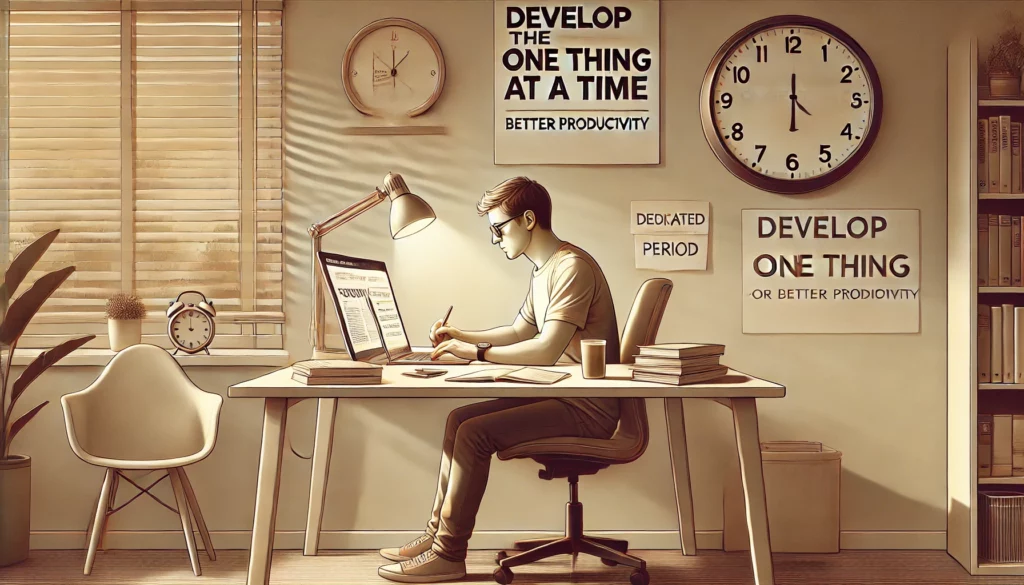In a world where everything seems to demand your attention at once, multitasking can feel like a superpower. Switching between emails, messages, and meetings might make you feel efficient—but in reality, it’s one of the fastest ways to lose focus and reduce the quality of your work.
Research shows that our brains aren’t built for multitasking. Every time we switch between tasks, it takes time and mental energy to reorient, leading to more errors and slower progress. If you’re constantly juggling, your brain never gets the deep focus it needs to do your best work.
The solution? Learn to do one thing at a time. It may sound simple, but building this habit can radically improve your focus, efficiency, and overall sense of control in your day.
In this guide, you’ll learn why single-tasking beats multitasking and how to train your brain to embrace deep focus—one task at a time.
Why Multitasking Reduces Your Productivity
Despite its popularity, multitasking doesn’t actually help you get more done. In fact, it often does the opposite. When you bounce between tasks, your brain wastes time re-focusing each time you switch. That constant context-shifting leads to lower quality work, more mistakes, and mental fatigue.
Here’s what happens when you multitask:
- You lose time refocusing every time you switch tasks
- Your stress increases from trying to manage too many things at once
- You’re more likely to make careless mistakes
- Tasks take longer to complete overall
Doing one thing at a time may seem slower—but it’s actually more efficient in the long run. The deeper your focus, the faster and better you work.
How to Build the Habit of Single-Tasking
1. Start with a Prioritized To-Do List
One of the biggest causes of multitasking is not knowing what to focus on. A clear to-do list helps you eliminate that uncertainty and concentrate on what truly matters.
Each day, choose just three key tasks to complete. Rank them by importance—not just by urgency. Then tackle the most important one first. Don’t move to the next until the current one is done.
Instead of writing vague tasks like “Work on project,” break them down:
- Research for 30 minutes
- Draft the outline
- Review and revise section one
Smaller, focused steps help your brain stay in the zone and resist the urge to bounce between tasks.
2. Use Time Blocking to Structure Your Day
Time blocking is a strategy where you assign specific chunks of time to each task. Instead of reacting to whatever comes up, you control your day with intention.
Plan your day in blocks of 60 to 90 minutes of deep work. Between each block, schedule short breaks to reset.
Example:
- 9:00–10:30 → Work on article
- 10:30–10:45 → Break
- 10:45–11:30 → Respond to emails
By giving each task its own space, you reduce the temptation to multitask and train your brain to stay focused on one thing at a time.
3. Eliminate Distractions Before You Start
No matter how well you plan, distractions can easily pull your focus away. Notifications, clutter, and interruptions are constant obstacles to single-tasking.
Before starting any task, take a moment to clean up your environment:
- Silence your phone or put it in another room
- Use website blockers to prevent online distractions
- Declutter your workspace
- Let others know you’re not available for a set period
Even five minutes of preparation can make a huge difference in your ability to focus deeply.
4. Practice the One-Tab Rule
Digital multitasking is one of the biggest productivity traps. If you’ve got ten tabs open, an email inbox pinging, and a chat window blinking, it’s nearly impossible to stay focused.
Try working with just one browser tab open. Close everything unrelated to the task at hand. Check emails and messages only during scheduled times.
For example, if you’re writing a report, keep only your document open. Avoid the temptation to Google something or check your inbox until you’ve finished the section you’re working on.
This simple habit trains your brain to stay in one mental lane.
5. Use the Pomodoro Technique to Maintain Focus
The Pomodoro Technique is a simple time-management system that helps you focus in short, productive bursts.
Here’s how it works:
- Choose one task
- Set a timer for 25 minutes
- Work with full focus, no interruptions
- When the timer goes off, take a 5-minute break
- After four cycles, take a longer 15–30 minute break
This method helps break the habit of task-switching and keeps your energy fresh throughout the day.
6. Try the “Before-After” Method to Prevent Switching
Many people switch tasks without realizing it—responding to a message in the middle of writing or jumping from a spreadsheet to a meeting note.
Before switching tasks, pause and ask yourself:
“Have I finished what I was working on?”
If not, finish it first—or intentionally decide to stop and come back later. Being conscious about transitions helps you reduce scattered attention.
7. Build Focus Gradually Over Time
If you’ve been multitasking for years, shifting to single-tasking takes practice. Your brain is used to jumping around, so you’ll need to retrain it gradually.
Start with short focus sessions of 10–15 minutes. When that becomes easy, increase to 30, then 60 minutes. If you get distracted, don’t criticize yourself—just take note and return to the task.
Keep a notepad nearby to write down distracting thoughts or urges. That way, you acknowledge them without acting on them immediately.
8. Reflect and Adjust Regularly
Building a new habit takes time. Reflecting on what’s working—and what’s not—helps you stay on track.
At the end of each day, take five minutes to review:
- What did you focus on well today?
- What distracted you?
- What could you change tomorrow to stay more focused?
This daily check-in reinforces your intention to single-task and helps you course-correct when needed.
Final Thought: Focus Is a Superpower
Multitasking might seem like the only way to survive a busy world, but the truth is, it slows you down and adds stress. Single-tasking, on the other hand, is a quiet superpower—one that allows you to do more, with less effort, and greater clarity.
When you commit to one task at a time:
- You work faster and make fewer mistakes
- You feel less overwhelmed by your to-do list
- You enjoy deeper satisfaction with your progress
So the next time you feel pulled in ten directions, stop. Pick one task. Close the tabs. Silence the phone. Breathe—and begin.
The more you practice, the more natural it will feel. One thing at a time. That’s where real productivity begins.
Gabriel Silva is the founder of Cursos e Soluções, a blog dedicated to personal growth, habit change, and self-discipline. Passionate about self-development and productivity, he shares practical, research-backed strategies to help people achieve their goals. He believes that small, consistent changes can lead to significant transformations over time and is committed to providing content that empowers both personal and professional success.







